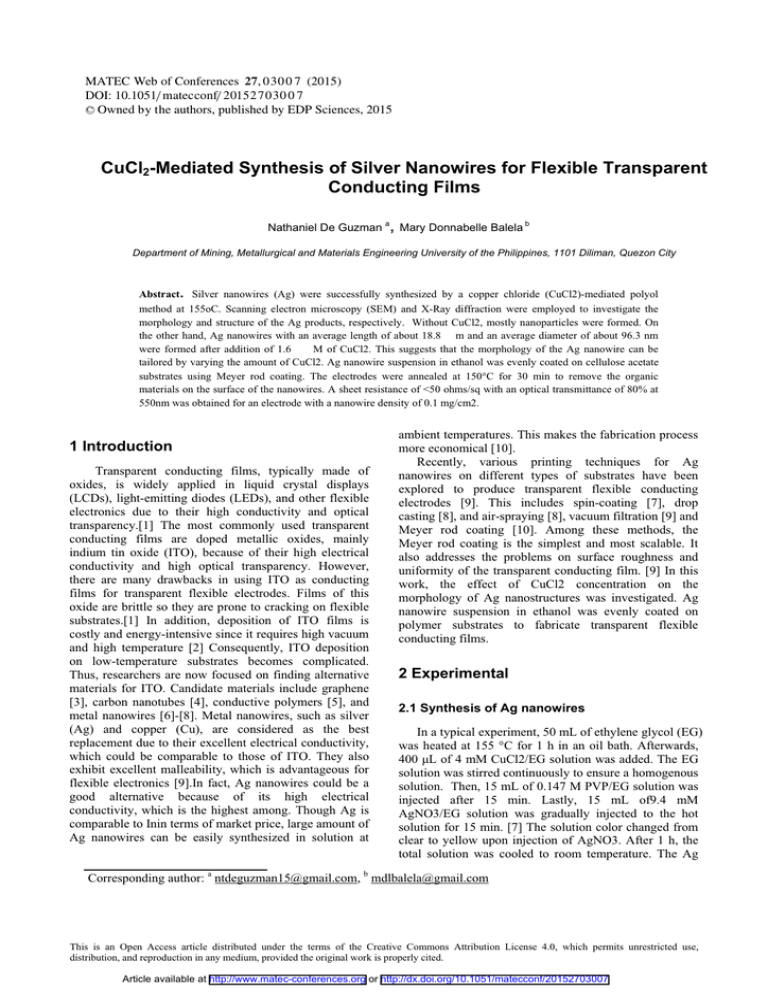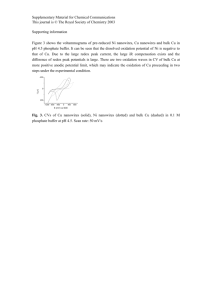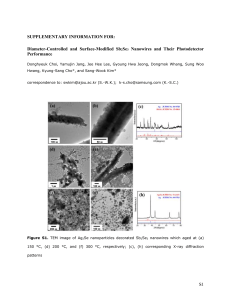CuCl -Mediated Synthesis of Silver Nanowires for Flexible Transparent Conducting Films ,
advertisement

MATEC Web of Conferences 27, 0 3 0 0 7 (2015) DOI: 10.1051/ m atec conf/ 201 5 2 7 0 3 0 0 7 C Owned by the authors, published by EDP Sciences, 2015 CuCl2-Mediated Synthesis of Silver Nanowires for Flexible Transparent Conducting Films Nathaniel De Guzman a, Mary Donnabelle Balela b Department of Mining, Metallurgical and Materials Engineering University of the Philippines, 1101 Diliman, Quezon City Abstract. Silver nanowires (Ag) were successfully synthesized by a copper chloride (CuCl2)-mediated polyol method at 155oC. Scanning electron microscopy (SEM) and X-Ray diffraction were employed to investigate the morphology and structure of the Ag products, respectively. Without CuCl2, mostly nanoparticles were formed. On the other hand, Ag nanowires with an average length of about 18.8 m and an average diameter of about 96.3 nm were formed after addition of 1.6 M of CuCl2. This suggests that the morphology of the Ag nanowire can be tailored by varying the amount of CuCl2. Ag nanowire suspension in ethanol was evenly coated on cellulose acetate substrates using Meyer rod coating. The electrodes were annealed at 150°C for 30 min to remove the organic materials on the surface of the nanowires. A sheet resistance of <50 ohms/sq with an optical transmittance of 80% at 550nm was obtained for an electrode with a nanowire density of 0.1 mg/cm2. 1 Introduction Transparent conducting films, typically made of oxides, is widely applied in liquid crystal displays (LCDs), light-emitting diodes (LEDs), and other flexible electronics due to their high conductivity and optical transparency.[1] The most commonly used transparent conducting films are doped metallic oxides, mainly indium tin oxide (ITO), because of their high electrical conductivity and high optical transparency. However, there are many drawbacks in using ITO as conducting films for transparent flexible electrodes. Films of this oxide are brittle so they are prone to cracking on flexible substrates.[1] In addition, deposition of ITO films is costly and energy-intensive since it requires high vacuum and high temperature [2] Consequently, ITO deposition on low-temperature substrates becomes complicated. Thus, researchers are now focused on finding alternative materials for ITO. Candidate materials include graphene [3], carbon nanotubes [4], conductive polymers [5], and metal nanowires [6]-[8]. Metal nanowires, such as silver (Ag) and copper (Cu), are considered as the best replacement due to their excellent electrical conductivity, which could be comparable to those of ITO. They also exhibit excellent malleability, which is advantageous for flexible electronics [9].In fact, Ag nanowires could be a good alternative because of its high electrical conductivity, which is the highest among. Though Ag is comparable to Inin terms of market price, large amount of Ag nanowires can be easily synthesized in solution at ambient temperatures. This makes the fabrication process more economical [10]. Recently, various printing techniques for Ag nanowires on different types of substrates have been explored to produce transparent flexible conducting electrodes [9]. This includes spin-coating [7], drop casting [8], and air-spraying [8], vacuum filtration [9] and Meyer rod coating [10]. Among these methods, the Meyer rod coating is the simplest and most scalable. It also addresses the problems on surface roughness and uniformity of the transparent conducting film. [9] In this work, the effect of CuCl2 concentration on the morphology of Ag nanostructures was investigated. Ag nanowire suspension in ethanol was evenly coated on polymer substrates to fabricate transparent flexible conducting films. 2 Experimental 2.1 Synthesis of Ag nanowires In a typical experiment, 50 mL of ethylene glycol (EG) was heated at 155 °C for 1 h in an oil bath. Afterwards, 400 μL of 4 mM CuCl2/EG solution was added. The EG solution was stirred continuously to ensure a homogenous solution. Then, 15 mL of 0.147 M PVP/EG solution was injected after 15 min. Lastly, 15 mL of9.4 mM AgNO3/EG solution was gradually injected to the hot solution for 15 min. [7] The solution color changed from clear to yellow upon injection of AgNO3. After 1 h, the total solution was cooled to room temperature. The Ag Corresponding author: a ntdeguzman15@gmail.com, b mdlbalela@gmail.com This is an Open Access article distributed under the terms of the Creative Commons Attribution License 4.0, which permits unrestricted use, distribution, and reproduction in any medium, provided the original work is properly cited. Article available at http://www.matec-conferences.org or http://dx.doi.org/10.1051/matecconf/20152703007 MATEC Web of Conferences products were collected by centrifugation at 3000 rpm for 20 min and washed with ethanol. This washing process was repeated 3 times to remove excess EG and PVP. The Ag NWs were then stored in ethanol. 2.2 Electrode fabrication and Characterization For the flexible transparent electrode fabrication, 2 x 2 cm cellulose acetate films were sonicated in acetone for 10 min, then in isopropyl alcohol (IPA) for another 10 min. Afterwards, the substrates were dried undernitrogen (N2) gas. 20 l of the Ag nanowire in ethanol solution was dropped on a substrate. A Meyer coating rod (#10) was then rolled over the solution to evenly coat the cellulose acetate films with Ag nanowires. The Ag-coated polymer substrates were then annealed at 150oC for 30 min to remove the organic layer on the surface of the Ag nanowire. The morphology of the Ag products was examined using scanning electron microscope (SEM, JEOL 5300). The structure was determined by X-ray diffraction (Shimadzu XRD-7000) using Cu Kα. The sheet resistance and visible transmittance of Ag nanowiretransparent conducting electrodeswere measured using Four-point probe (Jandell) and UV-Vis spectrophotometer(Agilent Tech.), respectively. 3 Results and discussion Fig. 1 shows the SEM images of the Ag products prepared in ethylene glycol in the presence of CuCl2. Without CuCl2,large spherical Ag particles were formed in the solution as seen in Fig. 1a. The particles have a mean diameter of about 155 nm. A few short Ag nanorods were also observed with the particles. Ag nanowires with a mean diameter of about 96.3 nm and length as long as 18.8 µm were formed after addition of 1.6 µM CuCl2. However, thicker Ag nanowires were formed when the CuCl2 concentration was further increased to 3.2 µM.In the presence of CuCl2, Cl possibly reacts with Ag(I) to form AgCl, which acts as intermediate phase. As result, Ag+ions are gradually released in the solution, facilitating the growth of Ag nanowires. The Cl ions also electrostatically stabilize the initially formed multiply twinned Ag seeds, which are critical for the formation of the nanowires. Additionally, the Cu(II) ions serves as oxygen scavenger and efficiently remove adsorbed atomic oxygen on the surface of the Ag seeds. Consequently, oxidative etching of Ag seeds is hindered [7]. Larger multiply-twinned seeds are formed due to the increase in CuCl2 concentration that lead to the increase in diameter of the nanowires as seen in Fig. 1c. Figure 1. SEM images of silver nanowires synthesized using a) 0 Fig. 2 shows the XRD pattern of Ag nanowires formed with 1.6 M CuCl2.The peaks at 38.21°, 44.12°, 64.82°, and 77.69° are peaks of the 111, 200, 220 and 311 face-centered cubic (fcc) Ag. [2] No peaks related to CuCl2 and AgCl are present in the diffraction pattern, suggesting that almost all Ag+ ions are reduced to metallic Ag and no separate Cu product is generated. Figure 2. XRD pattern of silver nanowires. M, b) 1.6 M and c) 3.2 M CuCl2. Fig. 3 shows the change in the sheet resistance and optical transparency for the Ag nanowire electrodes with increasing Ag nanowire density. The optical transmittance is determined at the wavelength of 550 nm. The substrate with a nanowire density of 0.05 mg/cm2exhibited a transparency of about 90 % with a sheet resistance of 85 ohm/sq. An increase in the amount of Ag nanowires on the electrodes led to a decrease in both the sheet resistance and transmittance. This is possibly due to improved connectivity between the wires, which allows the electrons to flow from one wire to another. However, the higher concentration of Ag nanowire on the substrate also decreases the holes between the wires, which lessens the amount of light that passes through the substrate.[9][10] As a result, the optical transmission of the electrodes is reduced. The lowest sheet resistance of <10 ohm/sq was achieved on the substrate with a nanowire density of 0.2 mg/cm2. However, the transmittance was decreased to < 60%. The as-prepared Ag NW suspension in ethanol, together with the coated cellulose acetate substrate is shown in Fig. 4. It was observed that the coating was uniform throughout the 03007-p.2 ICEIM 2015 surface of the substrate. The films are still conducting even after bending as seen from Fig. 4d. Figure 3. a) Optical transmittance and b) sheet resistance values of electrodes at increasing Ag nanowire density. An Ag nanowire density of 0.1 mg/cm2 resulted to a sheet resistance of 47.62 ohms/sq at a transmittance of 82% at 550 nm wavelength. Indeed, Ag nanowires is a promising material to replace ITO for future flexible electronic applications. Acknowledgment This study is supported by the Department of Science and Technology under the Philippine Council for Industry, Energy and Emerging Technology Research and Development. (DOST-PCIEERD) References 1. Figure 4. a) Ag NW suspension in ethanol. Images of a) acetate film coated with Ag NWs, b) conductivity test, and c) flexibility test. 4 Summary Uniform Ag nanowires were successfully synthesized by electroless deposition in ethylene glycol in the presence of CuCl2. The absence of CuCl2 in the solution resulted to the formation of nanoparticles. Meanwhile, the addition of a small amount of CuCl2 may have helped stabilized the nucleated seeds. Consequently, nanowires were formed. Flexible transparent conducting films were fabricated by coating ethanolic solutions of Ag nanowires on cellulose acetate substrates using a Meyer coating rod. Y. Xia, P. Yang, Y. Sun et al., Advanced Materials, 15, 353–389 (2003) 2. H. Mao, J. Feng, X. Mi, C. Wu, and X. Zhao, J. Nanopart Res, 14, 887-890 (2012) 3. C. Weber etal., Small-Nanomaterials, 6, 184–189 (2010) 4. Z. Wu. et al., Science, 305, 1273-1276 (2004) 5. S. Kirchmeyer and K. Reuter, Journal of Materials Chemistry, 15, 2077–2088 (2005) 6. J. Lee et al., Crystal Growth, 12, 5598−5605( 2012) 7. M. Johan et al., Journal of Nanomaterials, 2014, 1-7 (2014) 8. J. Zhu, C. Kan, J. G. Wan, M. Han and G. Wang, Journal of Nanomaterials, 1-7 ( 2011) 9. C. Yang et. al., Advanced Materials, 23, 3052–6 (2011) 10. V. Kiran Kumar, C. wan Bae, L. Piao, and S.-H. Kim, Materials Research Bulletin, 48, 2944–2949 (2013) 03007-p.3







